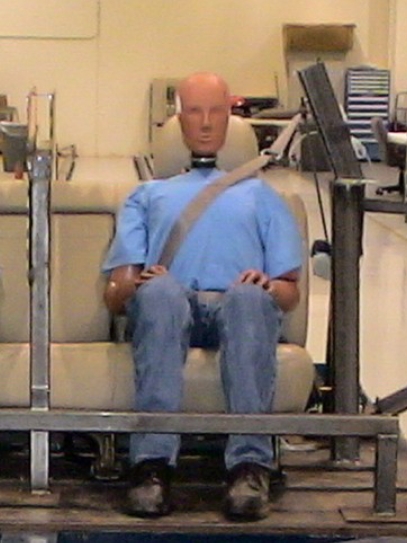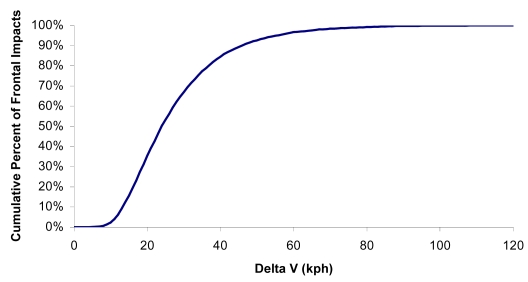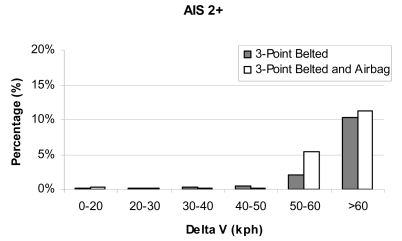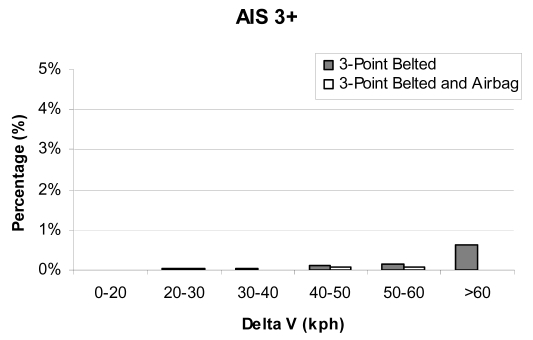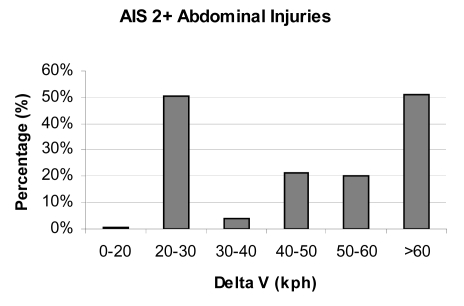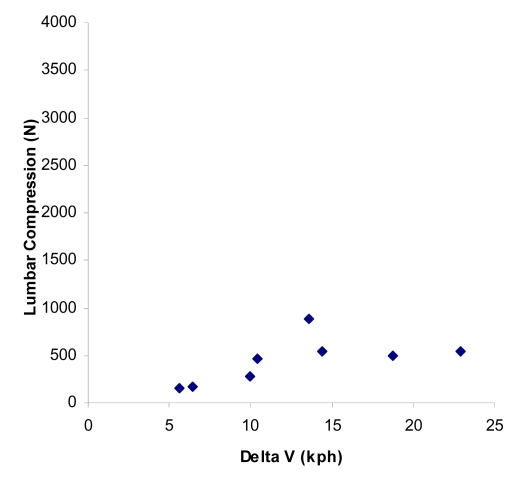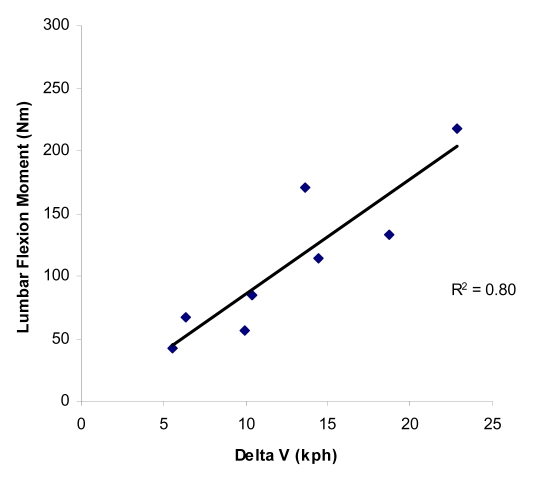Abstract
The increased utilization of three-point restraint systems has greatly reduced the incidence of spinal injuries in motor vehicle accidents. Nevertheless, several studies which rely upon the National Automotive Sampling System (NASS) have documented lower thoracic and upper lumbar fractures in restrained occupants involved in frontal collisions of moderate severities. Although it has been postulated that the injury mechanism may be related to the occupant being out-of-position or sitting in an unusual posture, conclusions with regard to the precise mechanism of injury are difficult due to the lack of information contained in the NASS database. In addition, previous studies have not reported statistical significance of these injuries. In this study, we combined statistical analysis of frontal collisions in the NASS database with the analysis of data acquired from sled and crash tests, which utilized anthropomorphic test devices (ATDs), in order to evaluate the incidence and potential injury mechanisms underlying thoracic and lumbar spine fractures in moderate frontal impacts. In the first portion of the study, we performed a statistical analysis of the NASS database to estimate the incidence rate of spinal fracture. This was complemented with measurements and analysis of lumbar spine load data derived from frontal sled and crash tests. Analysis of the NASS database demonstrated that thoracolumbar spinal injuries are rare when an occupant is restrained by a lap and shoulder belt, and are often accompanied by abdominal injury. The spinal loads measured during frontal impacts with restrained and nominally positioned ATDs were found to be well below injury thresholds. Our results also suggest that the potential for isolated fracture is increased when the geometry of occupant-to-restraint interaction is compromised, as occurs when an occupant submarines the lap belt.
INTRODUCTION
It is widely accepted that three-point restraint systems greatly reduce the number and severity of injuries in frontal collisions. However, case studies derived from entries in the NASS database and other crash injury databases (Huelke et al., 1995) have identified a number of cases where lap and shoulder belt restrained occupants sustained thoracic and lumbar spine fracture or dislocation in frontal collisions of moderate severity. Similar findings have been reported by Ball et al. (2000), who conducted a retrospective chart review at a regional spinal cord injury center and identified a number of cases where three-point restrained occupants sustained thoracolumbar fracture in frontal impacts. While the latter study did not involve an assessment of collision severity, the majority of the injuries involved a lower thoracic or upper lumbar burst fracture. Additionally, Miniaci and McLaren (1989) provided a collection of 4 case reports, wherein lap-shoulder belted occupants sustained an anterolateral wedge compression fracture of a thoracolumbar vertebra with lateral compression occurring on the side opposite the restrained shoulder. What is unclear from the case reports described above is the prevalence of thoracolumbar injury in three-point restrained occupants in frontal impacts, and the collision severities at which such injuries occur.
In this study, we combined statistical analysis of the NASS database with the analysis of data acquired from sled and crash tests in order to evaluate the incidence of thoracolumbar spine injuries amongst three-point restrained occupants in frontal impacts. Previous authors (Miniaci and McLaren, 1989, Huelke et al. 1995; Ball et al. 2000) reported incidents of thoracolumbar injuries occurring in cases where occupants were restrained only by three-point belts. Considering the prevalence of airbags in the modern vehicle fleet, we also conducted a NASS analysis of occupants restrained by three point belts supplemented by airbags.
In the first portion of the study, frontal collision cases were identified from the 1995 to 2004 NASS database where occupants sustained thoracic and/or lumbar AIS 2+ and 3+ injuries while restrained: (a) by a three-point belt (no airbag), or (b) by a three-point belt and deployed airbag. The incidence rate of these injuries was quantified, and accompanying abdominal injuries were identified. In the second portion of the study, experimental data from automobile crash and sled testing performed at Exponent was analyzed in order to quantify the loads present in the lower spine during frontal automobile collisions. The Hybrid III 50th-percentile-male ATD, which is widely accepted for use in frontal crash tests, was utilized in this testing.
METHODS
NASS DATABASE
NASS was developed in 1979 by the National Center for Statistics and Analysis (NCSA), part of the National Highway Traffic Safety Administration (NHTSA), as an investigative tool to aid in the reduction of motor vehicle crashes, injuries, and deaths on U.S. highways.
NASS is composed of the Crashworthiness Data System (CDS) and the General Estimates System (GES), both of which acquire data from police accident reports in randomly selected counties and cities comprising a representative segment of the United States. The CDS data specifically focuses on passenger vehicle crashes and the investigation of injury mechanisms, and contains detailed data on thousands of automobile crashes of varying severity. CDS researchers input data on approximately 5000 passenger vehicle crashes per year, and over 140,000 crashes have been included into the CDS system since its inception. CDS researchers obtain scene and accident data, inspect vehicles, document vehicle damage, estimate vehicle Delta-Vs, interview vehicle occupants, review occupants’ medical records, and classify the nature and severity of occupants’ injuries. All of these variables are coded and entered into the NASS CDS database (NASS, 2005).
Since it is not practical for researchers to investigate all automobile accidents, NASS uses an unequal probability selection procedure to obtain a sample of accidents to be included in the database. A simple random sample of all accidents would not provide effective statistics since it would result in a large percentage of low speed crashes with few injuries, since these types of crashes make up a large portion of all crashes. Instead, a weighting factor is assigned to crashes, which increase or decrease the probability of selection for inclusion in the NASS CDS database. All accidents reported in the NASS CDS database have an associated weighting factor, which can be used for statistical analysis. By using this sampling methodology the NASS CDS database is able to provide effective data across a wide range of accident severities and types.
The NASS CDS database uses the Abbreviated Injury Scale (AIS) coding system [AAAM, 1998] to classify all occupant injuries, and can record up to 10 injury entries for each occupant. Per AIS, all injuries are classified into nine body regions: head, face, neck, thorax, abdomen, spine, upper extremity, lower extremity, and unspecified. The injuries are further classified by severity, ranging in scale from 1 (minor) to 6 (currently untreatable).
The NASS CDS database from 1995–2004 was initially queried for all frontal collisions that were not preceded or followed by an additional harmful event (i.e., a vehicle-to-vehicle collision, vehicle-to-object collision, rollover, etc.). Frontal collisions were defined as a collision where the principal direction of force (PDOF) ranged between −30° and +30°. This frontal collision subset was then surveyed for front seat occupants, restrained by a lap and shoulder belt, who sustained thoracic and/or lumbar spine injuries. This query searched specifically for all AIS codes referencing injury to the thoracic or lumbar spine with a score of 2 or higher, excluding skin lacerations and lumbar nerve root injuries. The same frontal collision subset was also surveyed for front seat occupants restrained by three-point belts and deployed airbags.
The risk of injury to the occupant was assessed using the AIS injury classifications, and was evaluated in terms of an occupant sustaining at least moderate (AIS 2+) or serious (AIS 3+) injury.
CRASH TEST DATA
A total of eight vehicle-to-vehicle and sled tests, producing rearward occupant compartment Delta-Vs up to 22.9 kph, were performed. For all tests, a Hybrid III 50th-percentile-male ATD was used. The ATD had a stature of 1.7m, a weight of 78 kg, and was equipped with a seated pelvis. The sled and vehicle-to-vehicle crash tests involved ATDs restrained by lap and shoulder belts only (no airbags were deployed.) For all tests, the ATD instrumentation included a 3-channel lumbar load cell capable of measuring forces in the x and z direction as well as the moment about the y-axis. Lap and shoulder belt loads were also measured. The tests were documented using high-speed and real-time video, and still photographs.
Vehicle-To-Vehicle Tests
Six crash tests were performed in two configurations using similar 1983 Nissan Pulsar NXs (Figure 1, Table 1). Four of the six crash tests were performed with a full contact front-to-rear impact configuration, with the longitudinal centerlines of the bullet and target vehicles aligned. This configuration was run at bullet vehicle speeds of 9, 16, 24, and 33 kph. An angled contact front-to-rear impact configuration was utilized for the two remaining crash tests, with the target vehicle rotated 10 degrees counterclockwise from the aligned position. The angled configuration tests were conducted at bullet vehicle speeds of 6 and 16 kph. For all tests, the target vehicle was at rest prior to impact. Each vehicle was instrumented with two triaxial accelerometers mounted on the rocker panel at the left and right B-pillars. The Hybrid III 50th-percentile male ATD was positioned in the driver’s seat of the vehicle and secured with the available three-point restraint.
Figure 1.
Photograph illustrating pre-impact positioning of ATD in vehicle-to-vehicle tests.
Table 1.
Summary of vehicle-to-vehicle crash tests.
| Bullet Vehicle | ||
|---|---|---|
| Impact Speed (kph) | Delta-V (kph) | Impact Configuration |
| 8.8 | 6.4 | Full-Contact |
| 16.3 | 10.4 | Full-Contact |
| 23.7 | 14.4 | Full-Contact |
| 32.8 | 18.7 | Full-Contact |
| 5.8 | 5.6 | Angled-Contact |
| 16.3 | 9.9 | Angled-Contact |
In each test the available three-point restraint system was properly utilized. The lap belt was routed over the ATD’s rigid pelvis area, and the shoulder belt was routed across the chest and over the left shoulder.
Sled Tests
Two additional sled tests were performed using a Seattle Safety sled with a wire-bending decelerator (Table 2). Sled deceleration was recorded for all tests. A late-model production seat was mounted to the sled top plate, as shown in Figure 2. A Hybrid III 50th-percentile male ATD was positioned in the seat and secured with a three-point restraint that was mounted in accordance with restraint geometry measured in an exemplar vehicle.
Table 2.
Summary of sled tests.
| Delta-V (kph) | Peak Sled Accel. (g) |
|---|---|
| 13.6 | 8.2 |
| 22.9 | 14.1 |
Figure 2.
Photograph demonstrating the occupant, seat, and restraint configurations used in sled tests.
RESULTS
NASS DATABASE
The data from the 1995–2004 NASS CDS database consisted of 9262 front seat occupants involved in frontal collisions who were restrained by three-point belts (no airbags) and 4887 occupants restrained with three-points belts and deployed airbags Analysis of the distribution of impact severities (Figure 3) indicates that 80% of these impacts occurred at Delta-Vs below 37 kph. Tables 3 and 4 report statistics for occupants restrained by: (a) three-point belts only, and (b) three-point belts and airbags, respectively (Unrestrained and lap-belt only restraint conditions, as well as unknown impact severities were not included).
Figure 3.
Cumulative percent of weighted front seat occupants involved in frontal collisions, sorted by Delta-V.
Table 3.
Occupants restrained by three-point belts (no airbag) with AIS 2+ and AIS 3+ thoracic and/or lumbar spine injuries.
| Delta-V (kph) | Number of 3-point belted Occupants in Frontal Collisions | Weighted Number of 3-point belted Occupants in Frontal Collisions | Three-Point Belted Occupants with Lumbar and/or Thoracic Injuries | |||||
|---|---|---|---|---|---|---|---|---|
| Number Occupants with AIS 2+ | Weighted Number Occupants with AIS 2+ | Weighted Percent of Occupants with AIS 2+ | Number Occupants with AIS 3+ | Weighted Number Occupants with AIS 3+ | Weighted Percent of Occupants with AIS 3+ | |||
| 0–20 | 3778 | 2,865,921 | 6 | 3485 | 0.12% | 1 | 0 | 0% |
| 20–30 | 2986 | 1,476,383 | 20 | 1748 | 0.12% | 4 | 323 | 0.02% |
| 30–40 | 1382 | 379,602 | 12 | 932 | 0.25% | 2 | 106 | 0.03% |
| 40–50 | 617 | 101,675 | 11 | 549 | 0.54% | 2 | 101 | 0.10% |
| 50–60 | 273 | 40,857 | 11 | 813 | 1.99% | 2 | 59 | 0.15% |
| >60 | 226 | 14,469 | 22 | 1488 | 10.28% | 2 | 89 | 0.62% |
Table 4.
Occupants restrained by three-point belts and airbags with AIS 2+ and AIS 3+ thoracic and/or lumbar spine injuries.
| Delta-V (kph) | Number of 3-point belted Occupants in Frontal Collisions | Weighted Number of 3-point belted Occupants in Frontal Collisions | Three-Point Belted Occupants with Lumbar and/or Thoracic Injuries | |||||
|---|---|---|---|---|---|---|---|---|
| Number Occupants with AIS 2+ | Weighted Number Occupants with AIS 2+ | Weighted Percent of Occupants with AIS 2+ | Number Occupants with AIS 3+ | Weighted Number Occupants with AIS 3+ | Weighted Percent of Occupants with AIS 3+ | |||
| 0–20 | 1754 | 1130105 | 3 | 2974 | 0.26% | 1 | 0 | 0.00% |
| 20–30 | 1695 | 663607 | 10 | 927 | 0.14% | 1 | 242 | 0.04% |
| 30–40 | 803 | 184768 | 6 | 331 | 0.18% | 0 | 0 | 0.00% |
| 40–50 | 358 | 46281 | 3 | 85 | 0.18% | 1 | 37 | 0.08% |
| 50–60 | 156 | 12441 | 6 | 663 | 5.33% | 1 | 9 | 0.08% |
| >60 | 121 | 8718 | 11 | 985 | 11.30% | 0 | 0 | 0.00% |
Of the three-point restrained occupants, 82 sustained AIS 2+ thoracolumbar injury, and 13 sustained AIS 3+. Using the weighted data, the percentage of restrained occupants sustaining AIS 2+ and AIS 3+ injuries was computed across all severities (Figures 4 and 5). Since most modern vehicles are equipped with airbags, data for three-point restrained with airbag deployment (Table 4) was also plotted on Figures 4 and 5. As shown, injury rates for moderate (AIS 2+) thoracolumbar injury is less than 0.6% for severities up to 50 kph, but increases to 10.3% and 11.3%, respectively for three-point restrained and three-point restrained with airbag deployment at Delta-Vs greater than 60 kph. AIS 3+ thoracic and lumbar spine injury rates generally increased with increasing collision severity, but were less than 1% for both three-point restrained occupants and three-point restrained occupants with airbag deployment at all Delta-V levels.
Figure 4.
Percentage of three-point belted occupants with moderate or greater (AIS 2+) thoracic and/or lumbar spine injuries as a function of collision severity, separated by the presence or absence of a deployed airbag.
Figure 5.
Percentage of three-point belted occupants with serious or greater (AIS 3+) thoracic and/or lumbar spine injuries as a function of collision severity, separated by the presence or absence of a deployed airbag.
Additional analysis was performed to evaluate the percentage of occupants restrained by the three-point belts (no airbag) who sustained moderated or greater (AIS 2+) thoracolumbar injury and also sustained moderate or greater abdominal injury (Figure 6). Overall, 35% of occupants with moderate or greater thoracolumbar injury also sustained moderate or greater abdominal injuries. For Delta-Vs in the range of 20–30 kph and over 60 kph, this percentage was over 50%.
Figure 6.
Percentage of three-point belted (no airbag) occupants who also sustained AIS 2+ abdominal injuries (of those with AIS 2+ thoracic and lumbar spinal injuries).
CRASH TEST DATA
The data plotted in Figures 7 and 8 is a compilation of the lumbar load cell data from the sled and crash tests. As shown in these summary figures, the peak lumbar compression loads exhibited a maximum value of 882 N at 13.6 kph, and then leveled off with further increases in impact severity. Lumbar flexion moment, on the other hand, exhibited a linear increase (R2 = 0.8) with increasing collision severity.
Figure 7.
Maximum lumbar compression loads measured during frontal vehicle-to-vehicle and sled impacts.
Figure 8.
Maximum lumbar flexion moment measured during frontal vehicle-to-vehicle and sled impacts.
DISCUSSION
Previous studies (Ball et al., 2000; Huelke et al., 1995) have identified incidents of three-point restrained occupants sustaining thoracolumbar spine injuries in frontal collisions. In this study, a survey of the 1995–2004 NASS database also revealed incidents of thoracolumbar injuries in three-point belted occupants involved in frontal collisions; however, statistical analysis showed the rate of this occurrence to be quite low. At Delta-Vs of less than 50 kph, moderate or greater (AIS 2+) thoracolumbar spinal injuries occurred less than 0.6% of the time for both three-point restrained occupants and three-point restrained occupants with airbag deployment. Only at higher Delta-Vs was the incidence rate significant. At Delta-Vs of greater than 60 kph, the incidence rate increased to 10.3% for three-point restrained occupants and 11.3% for three-point restrained occupants with airbag deployment. Serious or greater (AIS 3+) injuries were exceedingly rare in collisions with Delta-Vs of less than 60 kph, as illustrated in Figure 5. For three-point restrained occupants, the rate of AIS 3+ injuries was less than 1% at all Delta-V levels, regardless of whether or not the three-point restraint was supplemented by airbag deployment.
Schmidt et al. (1975) and Kallieris et al. (1991) performed numerous frontal impact tests at 30 to 50 kph and 30 to 60 kph, respectively, which provide some insight into the increased incidence of moderate thoracic injuries (AIS 2) at Delta-Vs above 50 kph and particularly above 60 kph. In these tests, restrained cadaver occupants sustained injuries to the cervical and thoracic spine from the C1 to T4 levels; lower thoracic and lumbar injuries were not evaluated. Kallieris et al. (1991) reported the highest incidence of injury was at T1 and T2, with 46% of the vertebral column injuries classified as moderate or greater severity (AIS 2+). Unfortunately, the authors did not break down results by severity of impact.
Begeman et al. (1973) conducted a series of moderate severity sled tests using cadavers wherein strains were measured in the thoracolumbar spine, and vertical compressive forces acting along the spine were documented. In all, 40 runs were performed on 3 cadavers, with each cadaver sustaining wedging or compression fractures of the thoracolumbar spine. These investigators postulated that in frontal collisions, the curvature of the spine may result in high compressive loads in the thoracic and lumbar region. However, these tests were run with a non-automotive seat and double shoulder belts, which were horizontal as they passed over the shoulder. The non-conventional seats and belt configuration may have caused a wedging of the cadaver spine, resulting in higher than usual loads during these tests.
In contrast, our study used standard automobile seats and replicated true automobile restraint geometries. Experimental data from this series of automobile crash and sled tests at Delta-Vs ranging from 5.6 to 22.9 kph was analyzed. The maximum compressive load observed across the range of severities investigated was 882 N. For comparison, Willen et al. (1984) evaluated the strength of the L1 vertebrae under dynamic loading conditions, and identified a load level for fracture of 6000 to 10,000 N. These tolerance values are consistent with lumbar compressive strengths as collated from the literature by Jager and Luttman (1992), who indicated a mean compressive tolerance at age 40 of 6700 N for males and 4700 N females. The loads observed in our test series are also well below the 3400 N compression limit which is referenced by NIOSH in setting a Recommended Weight Limit for safe occupational lifting (Waters et al., 1993). Furthermore, biomechanical modeling studies, such as Chaffin and Page (1994), have demonstrated that loads well above 3400 N can be tolerated during lifting activities without injury.
As outlined previously, several authors have presented case studies where occupants have sustained injuries concentrated at the lower thoracic and upper lumbar spine. Although the Hybrid III ATD provides a single point load measurement at approximately the L-4 level, we anticipate this fairly captures the nature and magnitude of loading in the lumbar spine and provides a bound for the magnitude of loads in the lower thoracic spine. While this crash test series is limited to just two different productions of seats and lap-shoulder restraint geometries, it demonstrates that significant axial compression of the lower spine is not expected to occur in low-to-moderate severity frontal impacts for a properly restrained occupant, a position which is decisively confirmed by field data. Figure 7 indicates that the compressive lumbar loads do not continue their upward trend at the higher severities evaluated. It is postulated that increased forward torso motion and phase differences between the pelvic and torso restraint, associated with higher severities results in less compression in the lumbar spine.
Maximum flexion moments in the lumbar spine increased approximately linearly with increasing impact severity in this test series (Figure 8). However, even at the highest impact severities evaluated, the peak lumbar flexion moments were less than those that can be generated in the lower back during static and dynamic bi-manual lifting (approximately 300 Nm, Jager and Luttmann, 1992).
Nevertheless, our study of the NASS database did reveal a number of cases where thoracolumbar injuries were sustained at moderate Delta-Vs. Analysis of the NASS data revealed a correlation between abdominal injuries and thoracolumbar injuries for three-point belted occupants. Figure 6 illustrates that as many as 51% of occupants with thoracolumbar injuries sustained moderate or greater (AIS 2+) abdominal injuries. For collision severities of 20 kph or greater, overall approximately 35% of the occupants sustained AIS 2+ abdominal injuries. These results are similar to Ball et al. (2000), who did a retrospective case study of 37 patients with thoracolumbar injuries involved in frontal impacts. He found that 27% of patients required a laparotomy, indicating abdominal injury, but he did not correlate his results to collision severity.
The relationship between abdominal injuries and thoracolumbar injuries is important because it may provide an indication that the lap belt loaded the abdomen rather than interacting with the bony pelvic region. Injury potential is increased when the restraint geometry is compromised, which suggests that these thoracolumbar injuries may be related to belt misuse. It is interesting that only a small percentage of abdominal injuries were seen below 20 kph. Belt loads at this collision severity may not have been high enough to cause AIS 2+ abdomen injuries even if worn improperly.
CONCLUSIONS
Analysis of the NASS database indicates that AIS 2+ thoracolumbar injuries are rare during minor and moderate frontal collision severities when an occupant is restrained by a lap and shoulder belt with or without airbag deployment. The analysis shows that AIS 3+ injuries are exceedingly rare, demonstrating that these injuries represent an anomaly rather than the norm. NASS data further indicates that a large percentage of three-point restrained occupants sustained AIS 2+ abdominal injuries along with thoracolumbar spinal injuries, indicating that the occupant-to-restraint interaction was likely compromised. Frontal impact testing performed with properly restrained and nominally positioned ATDs revealed lumbar loads well below injury thresholds, and on par with those that can be generated during common lifting activities. The findings of this study indicate that thoracic and lumbar fractures are rare during minor and moderate frontal collisions when occupants are properly restrained with a three-point belt (no airbag) or with a three-point belt supplemented with an airbag.
REFERENCES
- 1.Abbreviated Injury Scale – 1990 Revision, Update. Association for the Advancement of Automotive Medicine; Des Plaines, IL: 1998. [Google Scholar]
- 2.Ball ST, Vaccaro AR, Albert TJ, Cotler JM. Injuries of the Thoracolumbar Spine Associated with Restraint Use in Head-On Motor Vehicle Accidents. Journal of Spinal Disorders. 13(4) doi: 10.1097/00002517-200008000-00005. [DOI] [PubMed] [Google Scholar]
- 3.Begeman PC, King AI, Prasad P. Spinal Loads Resulting from –Gx Acceleration. SAE 730977, Society of Automotive Engineers; Warrendale, PA. 1973. [Google Scholar]
- 4.Chaffin DB, Page GB. Postural Effects on Biomechanical and Psychophysical Weight-Lifting Limits. Ergonomics. 1994;37(4):663–676. doi: 10.1080/00140139408963681. [DOI] [PubMed] [Google Scholar]
- 5.Huelke DF, Mackay GM, Morris A. Vertebral Column Injuries and Lap-Shoulder Belts. The Journal of Trauma: Injury, Infection, and Critical Care. 1995;38(4) doi: 10.1097/00005373-199504000-00014. [DOI] [PubMed] [Google Scholar]
- 6.Jager M, Luttmann A. The load on the lumbar spine during asymmetrical bi-manual materials handling. Ergonomics. 1992;35(7/8):783–805. doi: 10.1080/00140139208967363. [DOI] [PubMed] [Google Scholar]
- 7.Kallieris D, Mattern R, Miltner E, Schmidt Gg, Stein K. Considerations for a Neck Injury Criterion. SAE 912916, Society of Automotive Engineers; Warrendale, PA. [Google Scholar]
- 8.Mertz HJ, Irwin AL, Prasad P. Biomechanical and Scaling Bases for Frontal and Side Impact Injury Assessment Reference Values. Paper # 2003-22-0009, Stapp Car Crash Journal. 2003;14 doi: 10.4271/2003-22-0009. October 2003. [DOI] [PubMed] [Google Scholar]
- 9.Miniaci A, McLaren AC. Anterolateral compression fracture of the thoracolumbar spine. A seat belt injury, Clin Orthop Relat Res. 1989;(240):153–6. [PubMed] [Google Scholar]
- 10.NASS brochure (2005) DOT HS 807 304 Rev. April 2005
- 11.Schmidt G, Kallieris D, Barz J, Mattern R, Klaiber J. Neck and Thorax Tolerance Levels of Belt-Protected Occupants in Head-On Collisions. SAE 751149, Society of Automotive Engineers; Warrendale, PA. [Google Scholar]
- 12.Waters TR, Putz-Anderson V, Garg A, Fine LJ. Revised NIOSH Equation for the Design and Evaluation of Manual Lifting Tasks. Ergonomics. 1993;36(7):749–776. doi: 10.1080/00140139308967940. [DOI] [PubMed] [Google Scholar]
- 13.Willen J, Lindahl S, Irstam L, Aldman B, Nordwall A. The Thoracolumbar Crush Fracture – An Experimental Study on Instant Axial Dynamic Loading: The Resulting Fracture Type and its Stability. Spine. 1984;9(6):624–631. doi: 10.1097/00007632-198409000-00014. [DOI] [PubMed] [Google Scholar]




